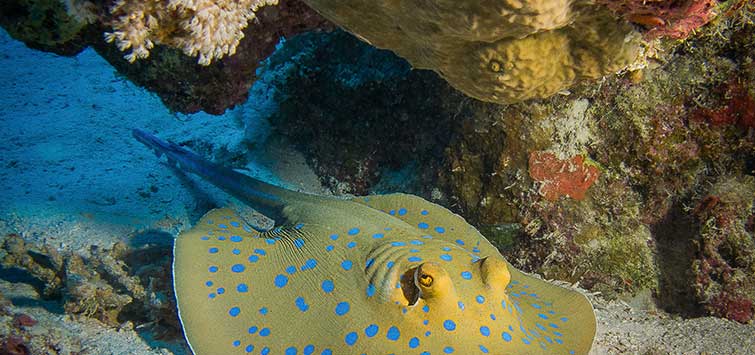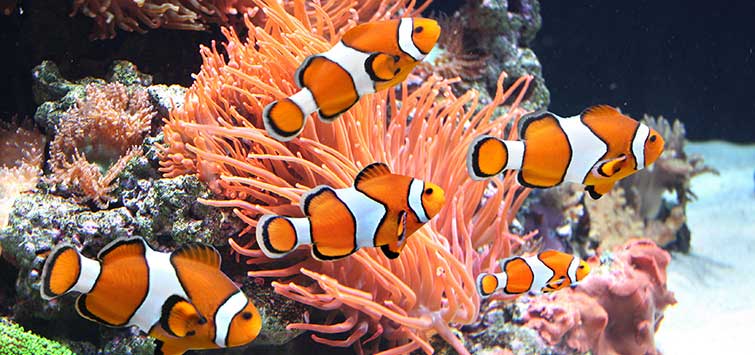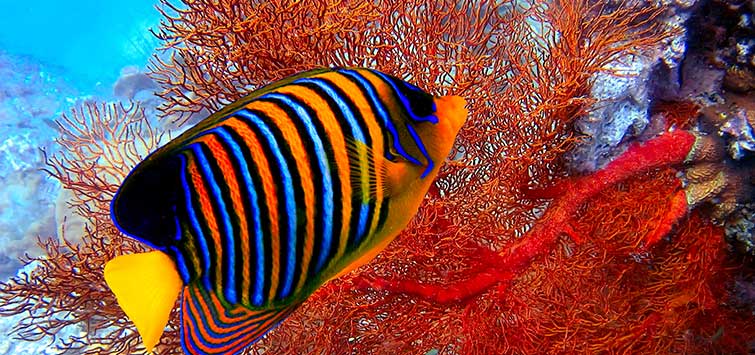Rays in the Home Aquarium
Author: Scott W. Michael
The world-renowned reef fishes authority describes some stingrays that can be maintained in a spacious home aquarium, with tips on their captive care.
Radiant Rays
While rays are not for every aquarist, these close relatives of the sharks can make fascinating aquarium inhabitants. It should be noted, however, that they do require lots of living space, which equates to investing in a very large aquarium. If you do not have the room in your home or the money to purchase the needed equipment, you would be better off considering some of the smaller reef fishes available to hobbyists. That said, I still believe that you would enjoy reading this article and learning more about these interesting animals. If you are willing to commit to the required financial outlay and do have the space, it is possible to keep certain species for long periods of time in the home aquarium.
We will start our survey of the rays most often found in the aquarium trade by briefly examining the aquarium system that would be required to house a ray. Then we will look at some of the ray families that may show up in your local aquarium stores and consider the pros and cons of each family.
Ray Species
Rays belong to the superorder Batoidea, which contains approximately 560 species. Only a small number of these fishes are available to home aquarists, and not all of those are well suited to the home aquarium. Some species get too large for all but the most expansive home systems, while some present real husbandry challenges. Below I have provided a brief examination of some of the rays that make it into the aquarium trade, with some notes on their captive care.
Torpedo Rays (Family Torpedinidae)
This family of electrogenic elasmobranchs has one genus and approximately 22 species. The torpedoes possess two kidney-shaped electric organs embedded under the skin on each side of the head. These organs are capable of producing an electrical discharge of over 220 volts in some species. Electrical discharge is used to capture prey, to ward off predators, and possibly to communicate with members of their own kind. People who have contacted these animals while wading or diving have reported that the shock is similar to being hit by a very large fist! Being shocked by a larger torpedo ray species could even result in unconsciousness.
Fishes make up the bulk of their diets, but they will occasionally eat shrimp and squid. The small jaws are distensible and enable the torpedo rays to eat large prey items relative to their body size. (Aquarists should be aware of their voracious appetites and their ability to ingest large prey items before selecting tankmates for a torpedo ray.)
Captive Care
The torpedo rays can be fascinating aquarium inhabitants. They spend most of their time buried under the sand, but having an opportunity to watch them feed is very interesting. While many of the torpedoes are quite hardy, some get much too large for the home aquarium.
One species of medium-sized torpedo, the panther torpedo (Torpedo panthera), is being regularly imported from the Red Sea and acclimates well to aquarium life. Torpedoes should be kept in a tank with no or minimal dÉcor, with a thick layer of finer sand on the aquarium bottom. Finer coral sand or aragonite sand is a good substrate choice for the torpedo tank.
Feeding
Feeding can be tricky. They will usually only take moving food. Live prey or a piece of fish presented on a feeding stick will usually fill the bill. In some cases they may pounce on a food item on the end of a feeding stick, but not ingest it if it immediately stops moving. Thus live marine fishes (e.g., damselfishes, cardinalfishes) may be needed to get a torpedo to break its initial fast.
Water Changes and Handling
Care must be taken when handling larger specimens, as they can give the aquarist a memorable zap! Do not use copper-based medications or trichlorfon on these animals. Also, use deionized or RO/DI water, not tap water, when topping up the torpedo tank or when mixing up salt water for water changes.
Electric Rays (Family Narcinidae)
This family of electric rays has four genera and approximately 30 species. The narcinids possess electric organs and can emit shocks of up to 37 volts, although more provocation is usually necessary to elicit electrical discharge than with the torpedo rays. They are found on soft mud and sand substrates, but several are residents of, or visitors to, reef environments.
Feeding
Unfortunately, due to their selective feeding habits, electric rays do not fare well in captivity. They feed primarily on annelid worms, both in the wild and in captivity, so unless you have access to a ready supply of those invertebrates, your chances of keeping an electric ray alive are slim. Attempts to get them to eat fresh fishes or shrimps have proven futile in most cases.
For those with access to coastal bait shops or a beach, live lugworms and clam worms are good food sources. The best way to feed your ray is to keep worms in the tank so it can feed on them at night. Smaller specimens should be fed worms of 1/2 to 2½ inches (1.25 to 6 cm.) in length. One Australian species has been kept alive for up to three months on a diet of fresh fish pieces and crushed snails.
Substrate
Electric rays should be kept on a fine-sand substrate to avoid abrasion, which will result in inflammation (bacterial infection) of their ventral surfaces. Such infections are usually fatal. In cement enclosures they have been observed to abrade their disc margins on the sides of the tank with the same unfortunate outcome. This problem may also occur in tanks where decorations such as hard coral skeletons are present. An appropriate electric ray tank should not include any sharp-edged or rough-surfaced decor.
Selection
When selecting an electric ray avoid individuals with curled disc margins or pale dorsal coloration, and avoid those that refuse to bury or feed. Captive specimens also fall victim to parasitic monogenetic trematodes (e.g., Amphibdelloides narcine) that infest the gills. These parasites can be treated by dipping the infected animal in halquinol (25 mg/L) and formalin (0.17 mg/L). Do not use copper-based medications or trichlorfon on these animals. Also, as with the torpedo rays, use deionized or RO water in the electric ray aquarium. Individuals can be kept together without concern about aggressive interactions.
Whiptail Stingrays (Family Dasyatidae) and Stingarees (Family Urolophidae)
The whiptail stingray family has 8 genera and approximately 88 species, several of which can be found in aquarium stores. Dasyatid rays have a large spine (or spines) on the tail, sheathed in venomous tissue; the spines are used as defensive weapons. When provoked, these fishes thrust the tail over their bodies and into the offender, whether it is a hammerhead shark or an aquarist’s hand. These rays eat a variety of invertebrates and fishes, and most dig in sediments for infaunal animals.
Round stingrays and stingarees are similar in morphology to the whiptail stingrays. The most conspicuous difference between the two is the well-developed caudal fin of the stingarees, which is lacking in the whiptails. Also, the urolophids are smaller (the largest species reaching about 32 inches [80 cm.] in length) and have shorter, broader tails. Of the 30 species in the family, most occur in temperate areas, and a number of them frequent rocky reefs. Stingarees have one or two spines on the tail and are responsible for injuring many bathers each year with this defensive weapon.
Captive Care
Both whiptail stingrays and stingarees should be kept in aquariums with a sand bottom (so they can bury themselves without getting injured) and minimal rockwork (a ledge to hide under would be “appreciated” by some species). No aggressive or sessile-invertebrate-eating tankmates (e.g., angelfishes, butterflyfishes, pufferfishes, or triggerfishes) should be housed with a stingray.
Most rays ship well and, with the exception of the bluespotted ribbontail ray (Taeniura lymma), usually feed within days of being purchased. Some will even accept fresh shrimp or fish out of their owner’s hand. The best food to use to stimulate feeding in a finicky stingray is live grass shrimp. The urolophid rays have very small mouths, and the juveniles have difficulty chewing fibrous foods, so these specimens can be fed shelled and finely minced shrimp, mussels, blackworms, and small live shrimp. Studies have demonstrated that at least one dasyatid feeds almost constantly day and night and consumes large quantities of food. In order to meet the metabolic demands of this species, and perhaps others, it is important to feed them frequently.
Bluespotted Ribbontail Ray
In my opinion, the bluespotted ribbontail ray is the most handsome member of the group but also the most difficult to keep. It often goes for a considerable time before it accepts fare in captivity, and most of the time it never makes the adjustment to aquarium life. For these reasons, this ray is best left in the wild. This ray is also very sensitive to copper. (Do not use copper-based medications, trichlorfon, or malachite green on any of these elasmobranchs.)
Tank Parameters
Another thing to consider is that whiptail stingrays require more living space than stingarees because the former attain greater sizes. Relatively little is known about the growth rate of dasyatids and urolophids.
Round stingrays, kept at a water temperature of 66 degrees Fahrenheit (19 degrees Celsius), grew at a rate of about 1 inch (2.5 cm.) of disc width each year until they reached sexual maturity, at which time the rate of growth decreased. At least some whiptail stingrays and stingarees will fight in aquarium confines. For example, the diminutive Atlantic stingray (Dasyatis sabina) is known to quarrel with conspecifics in aquariums.
More Information
While rays can be successfully housed in the home aquarium, they are not for everyone. For those of you who would like to dig deeper into the biology and husbandry of these animals, I would suggest Aquarium Sharks and Rays (2003) from TFH Publications. Yes, the latter reference is about freshwater stingray species, but it has lots of valuable information that also applies to saltwater forms.
See the full article on TFH Digital http://www.tfhdigital.com/tfh/september_2014#pg55

.png?h=595&iar=0&w=2781&hash=5FD5E69473BCC22199FBFA2FB71B6033)



